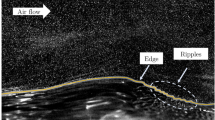Abstract
Turbulence energy is estimated in a backward-facing step flow with three-component (3C, stereo) particle image velocimetry (PIV). Estimates of turbulence energy transport equation for convection, turbulence transport, turbulence production, viscous diffusion, and viscous dissipation in addition to Reynolds stresses are computed directly from PIV data. Almost all the turbulence energy terms in the backward-facing step case can be measured with 3C PIV, except the pressure-transport term, which is obtained by difference of the other turbulence energy terms. The effect of the velocity spatial sampling resolution in derivative estimations is investigated with four two-dimensional PIV measurement sets. This sampling resolution information is used to calibrate the turbulence energies estimated by 3C PIV measurements. The focus of this study is on the separated shear layer of the backward-facing step. The measurements with 3C PIV are carried out in a turbulent water flow at Reynolds number of about 15,000, based on the step height h and the inlet streamwise maximum mean velocity U 0. The expansion ratio (ER) is 1.5. Turbulence energy budget profiles in locations x/h=4, x/h=6, and x/h=10 are compared with DNS data of a turbulent flow. The shapes of profiles agree well with each other. Different ERs between the PIV case (1.5) and the DNS case (1.2) cause higher values for the turbulence energies measured by PIV than the energies by DNS when x/h=10 is approached. PIV results also show that the turbulence energy level in these experiments is generally higher than that of the DNS data.
























Similar content being viewed by others
References
Adrian RJ (1991) Particle-imaging techniques for experimental fluid mechanics. Annu Rev Fluid Mech 23:261–304
Armaly BF, Durst F, Pereira JCF, Schönung B (1983) Experimental and theoretical investigation of backward-facing step. J Fluid Mech 127:473–496
Eaton JK, Johnstone JP (1980) Turbulent flow reattachment: an experimental study of the flow and structure behind a backward-facing step. Report MD-39, Thermosciences Division, Dept of Mech Eng, Stanford University, USA
Fincham AM, Spedding GR (1997) Low cost, high resolution DPIV for measurement of turbulent fluid flow. Exp Fluids 23:449–462
Forliti DJ, Strykowski PJ, Depatin K (2000) Bias and precision errors of particle image velocimetry. Exp Fluids 28:436–447
Foucaut JM (2001) Some considerations on the accuracy of derivative computation from PIV vector fields. In: Proc 4th international symposium on particle image velocimetry, Göttingen, Germany, 17–19 September 2001
Fouras A, Soria J (1998) Accuracy of out-of-plane vorticity measurements derived from in-plane field data. Exp Fluids 25:409–430
Furuichi N, Kumada M (2002) An experimental study of a spanwise structure around a reattachment region of a two-dimensional backward-facing step. Exp Fluids 32:179–187
Gui L (2001) Biases of PIV measurement of turbulent flow and the masked correlation-based interrogation algorithm. Exp Fluids 30:27–35
Hinze JO (1975) Turbulence, 2nd edn. McGraw-Hill, New York
Huang HT, Fiedler HE, Wang JJ (1993) Limitation and improvement of PIV. 1. Limitation of conventional techniques due to deformation of particle image patterns. Exp Fluids 15:168–174
Huang HT, Fiedler HE, Wang JJ (1993) Limitation and improvement of PIV. 2. Particle image distortion, a novel technique. Exp Fluids 15:263–273
Keane RD, Adrian RJ (1992) Theory of cross-correlation analysis of PIV images. App Sci Res 49:191–215
Kostas J, Soria J, Chong MS (2002) Particle image velocimetry measurements of a backward-facing step flow. Exp Fluids 33:838–853
Kuehn DM (1980) Effects of adverse pressure gradient on the incompressible reattaching flow over a rearward-facing step. AIAA J 18:343–344
Le H, Moin P, Kim J (1997) Direct numerical simulation of turbulent flow over a backward facing step. J Fluid Mech 330:349–374
Lourenco L, Krothapalli A (1995) On the accuracy of velocity and vorticity measurements with PIV. Exp Fluids 18:421–428
McKenna SP, McGillis WR (2002) Performance of digital image velocimetry processing techniques. Exp Fluids 32:106–115
Nogueira J, Lecuona A, Rodriguez PA (2001) Identification of a new source of peak locking, analysis and its removal in conventional and super-resolution PIV techniques. Exp Fluids 30:309–316
Ötügen MV (1991) Expansion ratio effects on the separated shear layer and reattachment downstream of a backward-facing step. Exp Fluids 10:273–280
Piché R (1998) Filtering the interpolant is equivalent to interpolating the filtered data. Int J Math Educ Sci Technol 29:305–311
Piirto M, Eloranta H, Saarenrinne P (2000) Interactive software for turbulence analysis from PIV vector fields. In: Proc 10th international symposium on applications of laser techniques to fluid mechanics, Lisbon, Portugal, 10–13 July
Raffel M, Willert C, Kompenhans J (1998) Particle image velocimetry: a practical guide. Springer, Berlin Heidelberg New York
Ronneberger O, Raffel J, Kompenhans J (1998) Advanced evaluation algorithms for standard and dual plane particle image velocimetry. In: Proc 9th international symposium on applications of laser techniques to fluid mechanics, Lisbon, Portugal, 13–16 July
Saarenrinne P, Piirto M (2000) Turbulent kinetic energy dissipation rate estimation from PIV velocity vector fields. Exp Fluids 29:300–307
Scarano F, Riethmuller ML (1999) Iterative multigrid approach in PIV image processing with discrete window offset. Exp Fluids 26:513–523
Sharp KV, Kim KC, Adrian RJ (1998) Dissipation estimation around a Rushton turbine using particle image velocimetry. In: Proc 9th international symposium on applications of laser techniques to fluid mechanics, Lisbon, Portugal, 13–16 July
Soloff SM, Adrian RJ, Liu ZC (1997) Distortion compensation for generalized stereoscopic particle image velocimetry. Meas Sci Technol 8:1441–1454
Spalding DB (1961) A single formula for the law of the wall. J Appl Mech 28:455–457
Westerweel J, Dabiri D, Gharib M (1997) The effect of a discrete window offset on the accuracy of cross-correlation analysis of digital PIV recordings. Exp Fluids 23:20–28
Willert CE, Gharib M (1991) Digital particle image velocimetry. Exp Fluids 10:181–193
Author information
Authors and Affiliations
Corresponding author
Rights and permissions
About this article
Cite this article
Piirto, M., Saarenrinne, P., Eloranta, H. et al. Measuring turbulence energy with PIV in a backward-facing step flow. Exp Fluids 35, 219–236 (2003). https://doi.org/10.1007/s00348-003-0607-z
Received:
Accepted:
Published:
Issue Date:
DOI: https://doi.org/10.1007/s00348-003-0607-z




